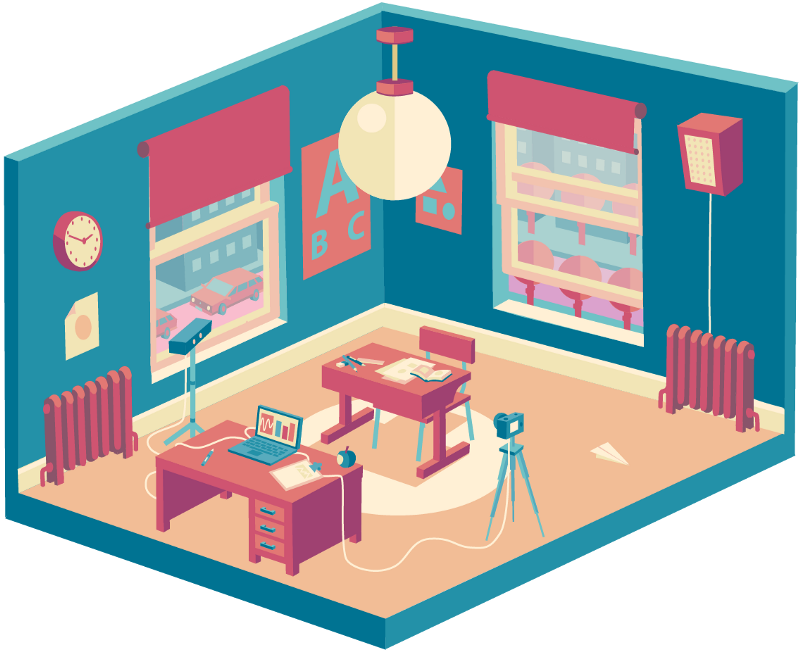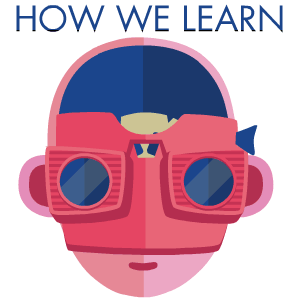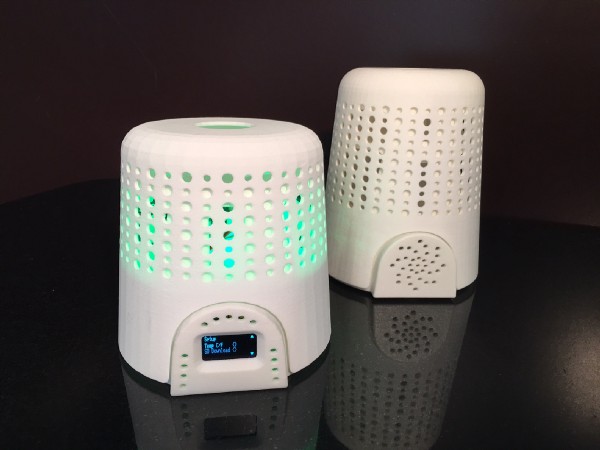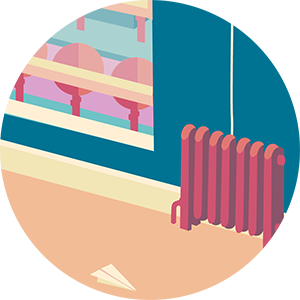

To understand the extent to which the fabric of a school can sabotage its students, Stephen Heppell believes we must return to the 1996 Summer Olympics. It was, for the British men and women who grimly took their seats on the plane home, the worst performance for his home country’s squad since 1952: just 15 medals in total, of which only one glittered gold.
In the months that followed, a scientific postmortem revealed a multitude of ways the team’s coaches had failed to implement basic adjustments to environment, diet, and training that could have, with just a little effort, produced significant performance gains.
Heppell, a schoolteacher, turned professor, turned grand inquisitor of educational practice–whom Microsoft once called “Europe’s leading online education expert”–has spent the majority of the past three decades investigating the importance of our physical surroundings when it comes to learning. In essence, he’s been looking at the ways temperature, humidity, air pollution, lighting, noise, and even architecture can spoil education.

The findings in this area of research are startling. According to Joshua Graff Zivin’s work for the National Bureau of Economic Research, pupil performance in a classroom vastly and linearly declines with every degree the temperature in the room climbs above 21 degrees Celsius [69.8 degrees Fahrenheit]. Ambient sound–the rumble and splash of student chatter, or the whir of a projector fan–has a similar effect above 72 decibels, as shown in numerous safety tests carried out by car manufacturers and tests for how well younger children can hear in noisy classrooms.
When a teacher closes the blinds, or fixes a display that blocks the sun from a window, light levels in the classroom fall, significantly harming children’s vocabulary and science test scores. When he or she closes a classroom door, the level of carbon dioxide begins to rise, often as high as 6,000 parts per million. A human’s ability to concentrate fails at levels around 2,200 parts per million.
“I haven’t been into an exam room that wasn’t hurting the children’s results,” says Heppel. While schools obsess over giving their pupils the best possible chance going into an exam, all of the 57 examination rooms that he has inspected in the past five months have been sub-optimal. “One had locked windows and a purple ceiling,” he tells me. “The room was between four and five degrees too hot, full of CO2, and the light level was less than 100 Lux. Any child walking into that exam would lose around five percent on their examination score before they even looked at the questions.”
This invisible damage extends beyond the classroom, too. “Almost every parent of a child at secondary school knows that their kid comes home from school bursting to use the toilet,” Heppell says. One study from 2005 shows that more than two-thirds of secondary-age girls have never defecated on the school premises and that most avoid having to urinate there as well.
“The reason is simple,” he says. “School toilets have doors that don’t fit properly, with big gaps at the top and bottom. Nowadays almost every kid on the planet is carrying a camera. Who would want to go to the toilet when there’s a chance they’ll be photographed with their pants down?”
Whether or not that’s the reason, if children are hesitant to use the bathrooms at school and thereby limit their liquid intake over the course of a day, the effects can be severe. A 2006 report by the United Kingdom’s Expert Group on Hydration found that a lack of adequate hydration at school can “have a devastating effect on quality of study and performance.” As well as affecting their general well-being, dehydration can cause children’s tongues to swell and make them begin to feel like clumsy talkers, reducing their likelihood to speak up or participate with others in lessons.
When a school installs airline-style bathrooms without peeking gaps and a sink inside–Jesmond Gardens School in Hartlepool, England, took Heppell’s advice and added futuristic, circular, self-contained cubicles–absentee rates fall and performance increases. “We’ve known this for ages,” says Heppell. “Yet schools continue to make toilets the same way they always have.”

In the decades leading up to the 1996 Olympics, British Athletics was, Heppell says, run by elderly white men in blazers. “They administered things well but we never won anything. They did things the way they did them because that’s how they’d always been done. There was no effort to maximize gains. That’s where we are right now in education.”
As a member of a 2009 review of home education for the British government, Heppell and company found that homeschooling rates in the United Kingdom have increased by 60 percent in recent years. Most parents who choose to teach their children, the panel concluded, were dissatisfied in some way with what was being offered by mainstream education.

To help educate the educators around fixing some of the problems, Heppell developed a device called a Learnometer, in conjunction with the British nonprofit Jisc. The box, which looks like a cross between a puckered mouth and a spaceship dock, monitors classroom environments, issuing warnings and advice about how to rectify present issues.
Now in its fourth prototype iteration (it officially goes out to schools in January 2017 at a cost of £50 per unit, or about $61), the device is a data gatherer as well as a dispenser. It uploads its recordings to the cloud, where teachers can then compare the results to previous months or years, or even to other schools in the area.
The idea is that the Learnometer will eventually be able to parse new information from the more data it collects. For example, if a classroom is too hot and too dark, and its CO2 is too high, which issue should the teacher prioritize? “We will know that at some point,” says Heppell.

Changing the classroom environment is one thing; monitoring the effects of that change is another. That’s why Amy Ogan, an assistant professor of Human-Computer Interaction at Carnegie Mellon University in Pittsburgh, has spent the past year working on a different device–one that can be seen as complementary to Heppell’s Learnometer.
Ogan’s invention employs voice recognition to help teachers gain a better understanding of their students’ level of engagement. The tool at present uses the beam-forming capabilities of the microphone arrays found in the over-specced and under-utilized Microsoft Kinect. When two of Ogan’s devices are positioned at the front of a classroom, they begin to locate and parse sound.
“A good teacher is constantly assessing their classroom, collecting much of this information without sensors,” Ogan says. “But novice instructors have so many things to pay attention to at once, from the instructional materials they are using, what each student already knows or is currently confused about, which explanation or example makes sense, whether students are engaged and paying attention.”
The device is able to distinguish between the teacher and student voices, and whether or not student contributions are coming from the front or back of the room, the left or right side. The results can be illuminating. In three recent tests conducted in computer science classes led by teaching assistants at the university, Ogan found that the TAs typically talked for more than 90 percent of each class. When the teaching assistants looked at the data in debrief meetings, they realized their lessons were not interactive. Ogan, for one, noticed that instructors barely waited for a response after asking a question–something research shows disincentivizes student interaction.
To help adapt their teaching styles in the classroom, the TAs were given a tablet displaying different colors depending on who was talking to rest on their lecterns. Whenever anyone stopped speaking, a three-second animation represented the amount of wait time studies have shown will lead to more participation.

None of these learning-focused technologies exists in a vacuum. Just showing people data without providing a context for what it means is, Ogan says, unlikely to help anyone think deeply about the needs of their classroom. Likewise, offering prompts to change behaviors–without understanding why in the first place–may produce a temporary fix but won’t necessarily lead to long-term change, her team has found.
When, however, the readouts from Ogan’s device were combined with teacher training on how to ask open-ended, elaborative, and knowledge-constructing questions, it had a dramatic effect. “We found that TAs ended the semester much more likely to believe in the value of student talk and in their own ability to connect with their students,” Ogan says. “Interestingly, the TAs started producing their own active learning strategies by independently deciding that they wanted [to do] to engage students more. They exhibited a sense of empowerment in developing [lesson plans] themselves. The change we have seen in beliefs about what constitutes good teaching is compelling.”
Compelling, perhaps, but there are still many experts who believe the role technology can play in solving problems in education is being exaggerated. “We often overstate the role of specific technology types or products in learning,” says Barbara Means, the director of the Center for Technology in Learning at SRI International, a California-based research institute. “A technology by itself is rarely, if ever, a solution to an education problem. It is usually just one piece of a broader learning experience.”
For Means, it’s inevitable that the way in which a technology aligns with other aspects of teaching will vary from instructor to instructor, something that makes collecting data about a technology’s effectiveness difficult. In fact, she says: “Many times technologies are touted to educators in the absence of any evidence at all.”
Despite her reservations, Means concedes that emerging technologies which are more unobtrusive and behind the scenes can help inform teachers about how students are learning, as well as what they’re learning. “Teachers using learning system instructor dashboards are starting to adapt their in-class activities to the needs of their students, as revealed by student actions on the digital learning system,” she says. “As we learn more about what learning behaviors to capture and we get more innovative in the ways we embed interactions that can serve formative assessment purposes, this instrumentation of learning should give teachers better and better information.”
It’s a goal that Ogan shares, even if her plans for the Carnegie Mellon tracking device could hardly be described as unobtrusive–the next step in her research will introduce facial tracking. This, she hopes, will monitor the moments at which students “tune-out,” something the device can pick up on by noticing when their faces go slack, their eyebrows rest, and their eyes begin to lose momentum.
“These are features that are much too complex for a novice instructor to continuously track on 20 students, let alone 200,” Ogan says. “But a system of sensors can help summarize what happened during a class and then give instructors the tools to review what happened–and consider whether the material at that moment was too difficult, too easy, or perhaps came late in the class when students were tired.”

We know more about how people learn today than at any other time in human history. Data science has helped us examine previously unanswered features of the human mind. But while much of the work has been applied to how desktop technologies can help students learn better and faster, there is an emerging disconnect between mind and body. In athletic terms, the physical needs of today’s students have been drastically overlooked thanks to a bias toward mental discipline.
There is a certain irony, then, that it’s fallen on digital technology to re-emphasize the importance of our bodies in the learning process–to recognize the skewering effects of too much heat, too little light, dehydration, and fatigue.
Much, however, remains for us to verify, let alone implement in our schools. “Today athletes know exactly what to eat the morning before a competition. But there’s very little research about what a young person should eat before an exam,” says Heppell. “Porridge in the winter? Bananas for potassium? Perhaps. All we really know right now is that having breakfast is better than having no breakfast. And that having a Red Bull is worse than either.”


How We Get To Next was a magazine that explored the future of science, technology, and culture from 2014 to 2019. This article is part of our How We Learn section, on the future of education. Click the logo to read more.
